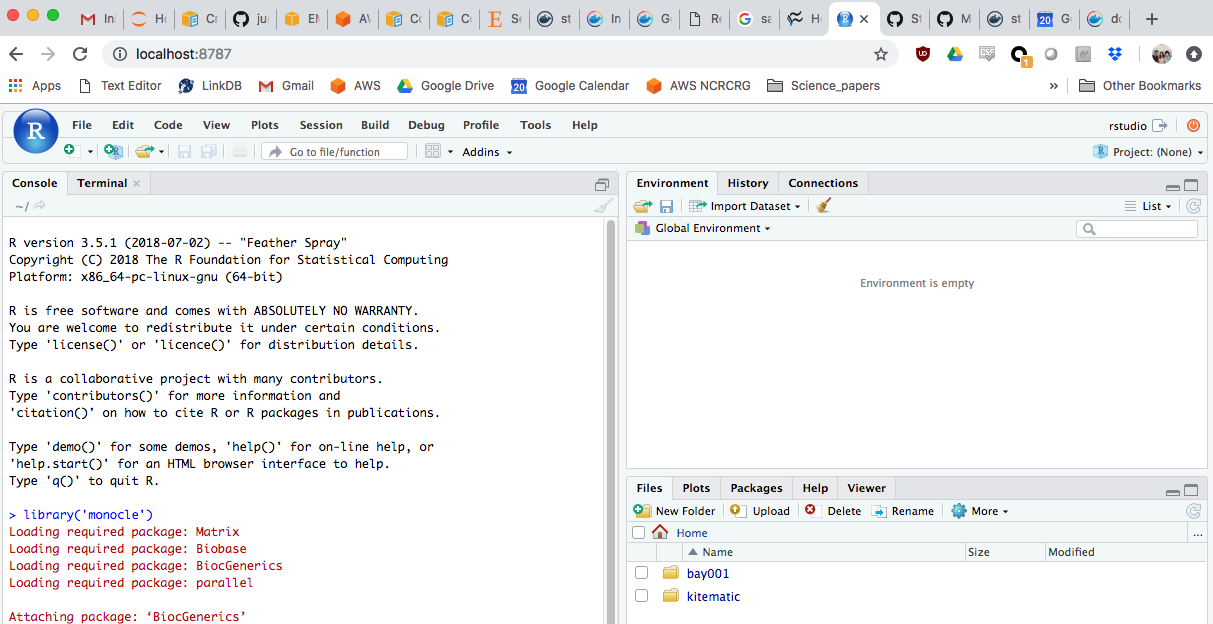byee4.github.io
Docker
Docker is a container system. You can think of Docker as a platform that allows you to run stuff with minimal installation or dependency issues.
Important things to note
- This pages shows how to install and run analyses locally, meaning your own computer needs to be able to handle the analysis
Installing Docker
Double click the Docker icon to start. It may ask you to sign in, which is optional unless you’re building/saving images on Dockerhub, which is a repository that stores Dockerfiles.
You can probably use this as a general cheatsheet to install and run any docker container, but as motivation for this page, I was looking to run an R package (monocle), and R packages sometimes aren’t the most straightforward to install.
Search for your package
I googled ‘ docker monocle’ and found a github repository from the Stuart lab which has not only provided the Dockerfile, but also wrote some nice instructions to install/onboard the image. I’ll explicitly write these steps down below for new Docker users (like me):
Verify docker installation
First let’s verify that installation worked by typing
docker
Which should provide some of the most useful Docker commands. These include:
- docker pull
- docker build
- docker run
- docker images
- docker ps
(Option 1): Pull a docker image from dockerhub
For example, there is a link to the Stuart Lab-maintained repository on Dockerhub, which will exist for any hosted repository: stuartlab/monocle
To the right, you should see a “Docker Pull Command”:
docker pull stuartlab/monocle
This is the same as:
docker pull stuartlab/monocle:latest
Which will pull the latest release. Alternatively, you should be able to substitute :latest
with any other tag/version (usually listed in the Dockerhub repo).
Typing and running this command will pull all of the layers of software required and build a monocle image based on the instructions provided from the Dockerfile.

(Option 2): Build a docker image from a Dockerfile
Alternatively, you can build an image directly from a Dockerfile itself, from the directory where the Dockerfile lives. (but I’d recommend Option 1):
git clone https://github.com/Stuartlab-UCSC/monocle-docker
cd monocle-docker
docker build .
Whether through (1) or (2), upon success, you should be able to see the image built by typing:
docker images
Make note of the image ID

In this case, the image ID corresponding to our monocle container is f9e6a444bfc8. I built this
image from a Dockerfile, so it has no tag info, but if you built through Dockerhub, it will usually
list a tag corresponding to the repo/version built.
Create a directory
Docker containers usually run independently, which means your standard filesystem will not be available. We’ll need to create/define a directory to mount/connect to the container, so that when you save stuff, it will persist after your container is destroyed.
mkdir ~/Documents/monocle-data
(Optional) Install sshfs
With sshfs, you can mount your TSCC drive to a local directory. Instead of creating a local directory, you can then mount that mounted directory onto your Docker container, essentially creating a bridge between files on TSCC and files inside your Docker container.
(tscc) /home/bay001 -> (local) /Users/brian/bay001/ -> (docker) /home/rstudio/
Instructions for installing sshfs on mac (sorry windows)
Creating and running your container
Once you have a directory and an image, you can now create a container. In addition to Monocle, this image also had instructions to install RStudio, which is a nice interface for R, but requires a username/password (pre-defined initially as rstudio/rstudio, although you’ll have to create a new password). This information usually gets destroyed when your container gets destroyed, so just create any new password at the start that you can use every time you run the same container.
RStudio also requires port information - you may keep this at 8787 or change to another, it doesn’t
matter. What’s important is the image name (f9e6a444bfc8) that you can see from typing docker images
and the mount point:destination (-v): -v ~/Documents/monocle-data:/home/rstudio/
docker run -v ~/Documents/monocle-data:/home/rstudio/ -e PASSWORD=password -p 8787:8787 f9e6a444bfc8
Run RStudio (and monocle)
Now you should be able to open a web browser and login to RStudio using the port defined above:

Try running ```library('monocle')``` in RStudio!
## Loading/saving files
You can load/save files, including any Rscripts on the mounted directory defined earlier.
## Listing all containers
Since you can technically run multiple containers at once, sometimes it's useful to list all containers
running (or stopped):
```docker ps -a```
```-a``` is used to list all containers, whether it's running or not. ```docker ps``` will just list running containers.
You probably only need one running container; if you need more than that, you probably shouldn't be reading this tutorial
## Stopping/starting a container
To stop a running container, you can either press ```Ctrl+C``` in the same window you launched the container
from, or by typing ```docker stop <container ID>``` where ```<container ID>``` can be found using ```docker ps -a```
To start a stopped container, you can type ```docker start <container ID>```
# Other useful commands
```docker images``` - list all images
```docker rmi <image_id>``` - remove an image
# Creating a Singularity image from Dockerfiles
There are probably way cleaner ways to do this, but this way is kind of a workaround
to get singularity images to run on TSCC (which does not have Docker installed).
- Install [Singularity](https://singularity.lbl.gov/install-linux)
- Create a Singularity file from any Docker repository. The most basic file (from Docker)
contains two lines. These lines will build a Singularity image directly from
the Docker repo.
```buildoutcfg
Bootstrap: docker
From: brianyee/cutadapt
- Build the image.
sudo singularity build cutadapt.img Singularity.cutadapt - Run the image.
singularity run cutadapt.img